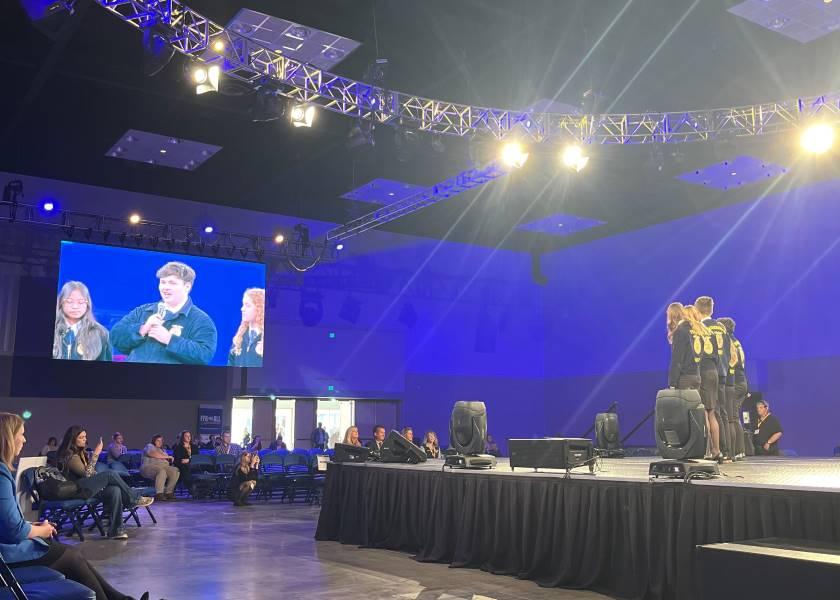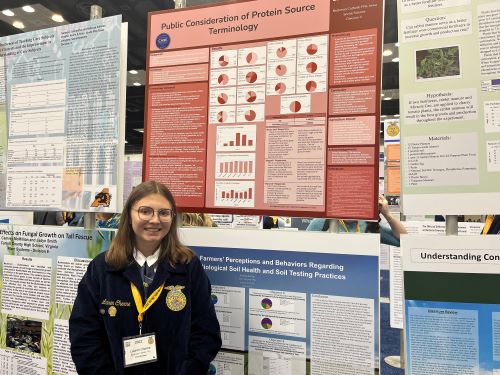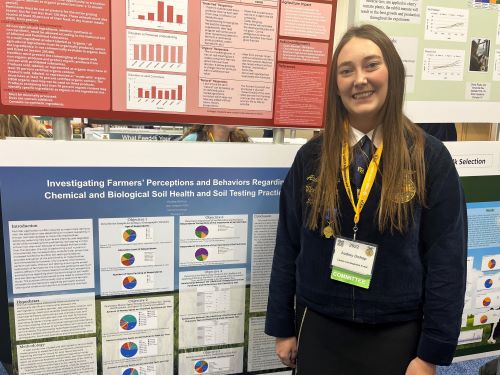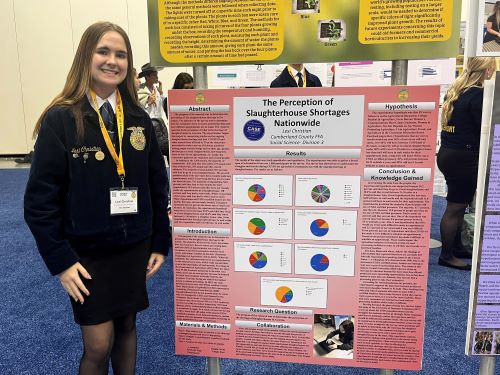Challenge? Bring It On, Say National FFA Agriscience Fair Competitors

Sometimes the greatest lesson we can learn in life is how to not see a setback as a failure. Jennifer Waters, program advisor for the Facilitating Coordination in Agricultural Education, says this is one of the most valuable lessons students learn by participating in the National FFA Agriscience Fair.
Waters has been helping with the Agriscience Fair in Illinois for the past nine years at the state level – not to mention she has personal experience with her own freshman agriscience project years ago putting fertilizer on plants to see if they grew better.
“The students involved in the National FFA Agriscience Fair have the unique opportunity to showcase their knowledge and skills through problem-solving and investigation,” Waters says. “Their projects never cease to amaze me with their desire to learn and advance the agriculture industry.”
FFA members in the Agriscience Fair program are working to better understand the people agriculture serves, as well as technical issues ranging from how to develop the best constructed structures to how to deal with pests plaguing our trees, she explains.
Even more importantly, these students are preparing themselves for a successful future in the workforce.
“I believe these students are ready to face both successes and failures because of their participation in the Agriscience Fair,” Waters says. “Going through critiques along the way from teachers, peers and industry professionals, has prepared these students to make changes as needed and not see setbacks as failures. A challenge isn't the end of the road for these students; just another critique.”
Waters explains that each state submits written applications for their state winners in each division and category to the National FFA in July. A committee narrows down the applications to the top 10 in each division and category. The score assigned by this group counts for 25% of their overall score. The remaining 75% of the score comes from the virtual interview that was conducted in September.
This year’s national competition drew in 739 entries from throughout the country. For the first time ever, the top 10 students in each division were brought onto the stage during various sessions of the National FFA Convention for recognition as compared to the top three in past years. Some students were also invited to participate in the Student Showcase to present a "TED-like talk" about their research.
The Agriscience Fair has been going strong for 24 years, says Madeline Young, program specialist in the programs and events division of the National FFA organization.
“It’s all about exploring your interest,” Young says. “Agriscience research is one type of supervised agricultural experience (SAE). Agriscience Fair is a great extension to a student’s SAE program. Research SAEs are a great way for students to get involved with FFA, who do not have the interest in or resources for production or placement-type SAEs.”
Here's a look at some of projects on display during the social science division’s poster session.

Public Consideration of Protein Source Terminology
By Lauren Cherne, Beckman Catholic FFA, Iowa
4th Place in Social Science Division 5
When Lauren Cherne was in the 8th grade, she started participating in the FFA Agriscience Fair. She says it allowed her to combine her love for agriculture and science along with her desire to develop public speaking skills.
This year she decided to study protein labeling in her social science project. Her findings showed that many people are not informed about protein labeling and there was great confusion on what labels actually meant.
“My biggest takeaway is that producers need to know who their demographic is so they can better target their consumer audience. Consumers need to know what different labels on their product mean so they know what they are purchasing and can better support farmers and ranchers,” Cherne says.
Participating in the National FFA Agriscience Fair poster session was a great opportunity to meet new people, she adds.
“I feel welcomed by each and every person I talk to, and it makes me feel like a part of something bigger than myself,” Cherne says.

Investigating Farmers’ Perceptions and Behaviors Regarding Chemical and Biological Soil Health and Soil Testing Practices
Audrey Bishop, Van Alstyne, Texas
2nd Place in Social Science Division 5
Audrey Bishop is no stranger to the National FFA Agriscience Fair. She’s had a successful track record over the years which helped her obtain a freshman research scholarship at Oklahoma State University.
Back in high school, she conducted an agriscience experiment the summer after her freshman year after a class discussion.
“We discussed how farmers often use wastewater to irrigate their crops in one of my classes. At that same time, my dad was put on a large amount of antibiotics for a bacterial infection in his sinus cavity. The doctor explained to him that his body would not completely metabolize the antibiotics,” Bishop says.
Those two events made her question how the antibiotics being released into the environment by humans could affect plants and crop yields, so she decided to conduct an experiment to answer her questions.
“At the end of my research, I found that I still had more questions than answers, so I continued researching in the following years and fell in love with research,” Bishop says.
In addition to her project examining the effects of antibiotics and probiotics on crop yields and soil microbes, she decided to take on a new research project this year examining farmers' perceptions and behaviors related to soil testing and fertilizer applications.
“My research project found that farmers are spending a lot of money to apply fertilizer to their fields. However, they are not spending a lot of money on soil testing or soil microbe testing,” Bishop says. “Unfortunately, especially with the rise in cost of fertilizer over the past year, many farmers are often pouring money down the drain because those fertilizers are not able to return into usable forms that can be taken up by the plants.”
Upon graduation from Oklahoma State, Bishop hopes to attend law school and eventually write policy related to the research she has conducted. She also hopes to develop a more standardized test farmers can use to test for soil microbes since the tests that are currently on the market are cost-prohibitive and not efficient.

Can Agriculture Teachers Adequately Teach Students with an Orthopedic Impairment?
By Nicholas Tarver and Abigail Manuel, Florien FFA, Louisiana
8th Place in Social Science Division 4
Nicholas Tarver is orthopedically impaired, but he determined, along with the support of his friend and fellow FFA member Abigail Manuel, not to let him miss out on not only experiencing, but thriving, in FFA. Together, they set out to bring awareness to the topic of orthopedically impaired students in the ag classroom with their social science project.
“We wanted to determine if ag teachers adequately teach students with orthopedic impairment. Can these students be successful in FFA like me? We discovered through our research project that they can,” Tarver says. “They can do everything that all these FFA members can do here at National FFA.”
Manuel and Tarver discovered some important strategies to share with advisors through their project, including being aware of classroom obstacles, considering the comfort of students and storage for assistive devices, promoting movement and exercise in class, allowing additional timing and providing adequate space to work.
“One thing that stood out to me about the results of our project was that ag teachers were excited and wanted to make accommodations to help students feel involved and included in their ag programs,” Manuel says.
She adds that her favorite part of being at National FFA Convention this year was being able to meet and converse with people with a similar background from all over the country.

The Perception of Slaughterhouse Shortages Nationwide
By Lexi Christian, Cumberland County FFA, Tennessee
2nd Place in Social Science Division 3
Lexi Christian didn’t willingly jump at the chance to complete an Agriscience Fair project. In her freshman honors agriscience class, her teacher made everyone participate as a grade.
“I placed in the bottom of my class,” Christian says. “When it came around to do the Agriscience Fair again my sophomore year, I had no interest in participating. However, my advisor encouraged me to do the same project, but make it better. She believed in me when I had no faith in myself. I never would have imagined I would have made it this far.”
Christian’s project took a deeper look at slaughterhouse shortages to determine how widespread issues were, who was being affected by them and how the problem could be solved in the future.
“When I started my project, I wanted to shine a light on the decrease in slaughterhouses across the nation. The findings of my survey have led me to understand that there is a dire need for more slaughterhouses in our area,” Christian says. “My school is currently applying for a grant that would allow us to build a small processing facility on our campus.”
She says her favorite thing about National FFA Convention is talking to all the different people.
“I love running into people that I’ve seen before from my home state and meeting new people from around the nation,” Christian says.
Check out the complete results of the 95th National FFA Convention’s Agriscience Fair.
Read More from FFA Convention:
Ohio's Jacob Wuebker Named 2022 Star in Agricultural Placement
National FFA Convention: Farm Journal's Inside Perspective
6 Dos and Don’ts to Make the Most of National FFA Convention
Read More about FFA:
Why You Should Prioritize People
4 Ways FFA Shaped My Life for the Better
FFA Has-Been? No, Your Role Just Changes







